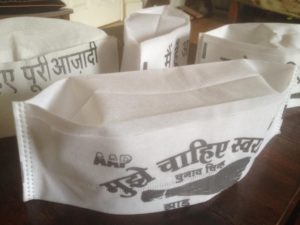At the onset of the 1930s, anti-Gandhi hysteria amongst the British in India was close to boiling point. This was largely thanks to the now iconic Salt March, where over 24 days, he led a non-violent protest to the Arabian Sea in protest at salt taxes. The British clamped down on this movement, arresting tens of thousands, including Gandhi himself on the 5th May.[1]
This event sparked civil disobedience throughout India. The response of the British was one of righteous indignation, with one paper reporting that, ‘consciously or unconsciously, Mr. Gandhi is playing a dangerous game. In the name of Ahimsa he is actually promoting violence, not only in feeling but in act. Within the week just ending all the Presidency towns and every city has witnessed scenes of wilful rioting and excesses by mobs’.[2]
I was surprised therefore, when in the very same newspaper I read the following, terse report from Bombay dated a couple of weeks previously:
‘The bullion, cotton share and cloth markets in the city have posted special notifications forbidding admission of all Indians wearing foreign head-gear to their respective places of business. Gandhi caps are being freely distributed’.[4]
These hats had long been associated with the home-rule movement, first being worn by Gandhi in 1919, and soon entering into mainstream popularity, being sold at pro-independence meetings in the early 1920s.[5] The British response had been swift, with cap-wearers suspended from Government jobs, fined or even beaten.[6] Such hats have therefore maintained political significance up to the present day, with the anti-corruption Aam Aadmi (common man) Party dishing out tens of thousands of these cheaply made caps emblazoned with party slogans at rallies from 2012 onwards.[7]

AAP Gandhi Hat (Andrew Whitehead)
Against this backdrop therefore, this report seems somewhat paradoxical. Having previously banned it, and at a time when Gandhi was coming to be considered pariah-in-chief in India, the British authorities seem to have tolerated the open distribution of one of his most iconic symbols.
What conclusions can we draw therefore from this anecdotal news article? The fact that three of the most important markets in the city had banned ‘foreign’ head-gear seems significant, as it suggests that domestic cloth manufacturers were feeling the strain of competing with foreign imports (coupled with the ongoing economic fallout from the Great Depression). The fact that Gandhi caps were being freely distributed as well points to the open support of independence by some of the leading merchant’s associations of the city. In this context then, the British tolerance of the manufacture and distribution of Gandhi hats, even to the detriment of imports, can also be seen in light of needing to prop up Indian industries. It also potentially demonstrates how Indian cloth merchants could use this rising nationalist tide to spur and stimulate their own industries, using it as an excuse to prevent competition. This isolated case therefore demonstrates the often grey area between political and economic nationalism, with the latter frequently fuelling the former across South East Asia in the 1930s.
[1] ‘Salt March’, History.com, 16th Jan 2020
[2] Rangoon Gazette and Weekly Budget, 5th May 1930, p7
[3] Ibid., p24
[4] Rangoon Gazette, ‘Free Distribution of Gandhi Caps in Bombay: Bullion and Other Markets object to foreign headgear’, 14th April, p2
[5] Andrew Whitehead, ‘Radical Objects: The Common Man’s Gandhi Cap’, History Workshop, 17th April 2014
[6] Lata Singh, Popular Translations of Nationalism: Bihar, 1920-1922, (Delhi 2012)
[7] Andrew Whitehead, ‘How India’s iconic Gandhi cap has changed sides’, BBC, 28th April 2014